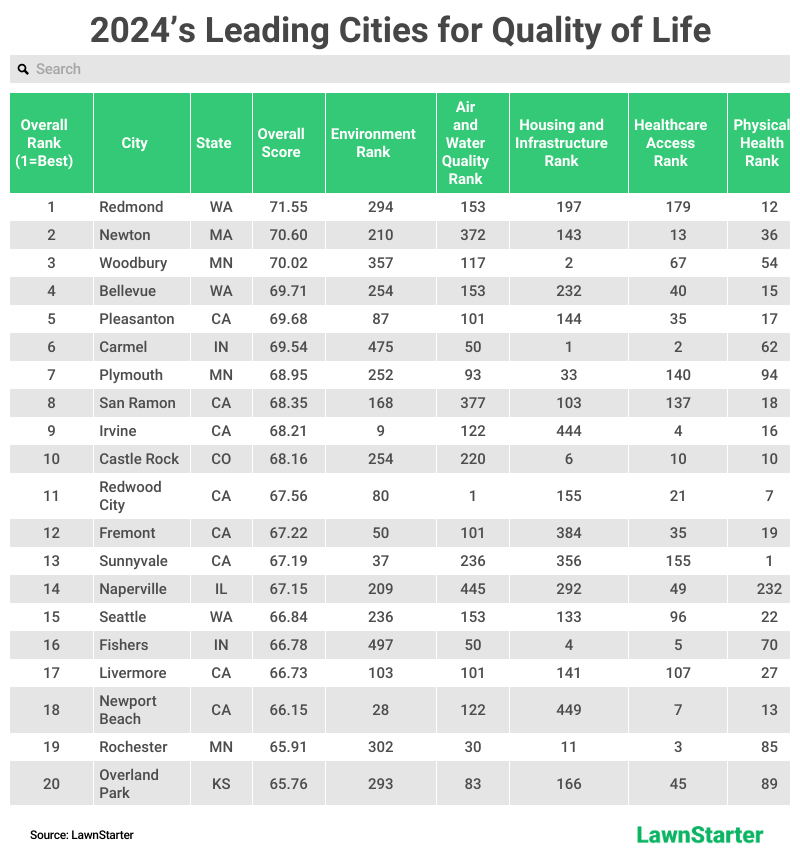
2024's leading cities for quality of life
This story was produced by LawnStarter and reviewed and distributed by Stacker Media.
2024's leading cities for quality of life
Four U.S. cities in coastal states and one in the Midwest are setting the gold standard for quality of life, according to the LawnStarter ranking of 2024's Leading Cities for Quality of Life.
The list compared 500 of the biggest U.S. cities based on 16 categories. It considered life expectancy, unemployment rates, state rankings of workers' rights, and food security, among 53 total metrics.
See where your city landed below. To learn how cities were ranked, see the methodology.
City Rankings
See how the top 20 cities fared in our ranking:

Top 5 Close Up
1st = Highest Quality of Life
No. 1: Redmond, Washington | Overall Score: 71.55
- Education: 3
- Employment Protection: 9
- Economic Stability: 18
- Family and Food Security: 26
- Leisure Time: 20
No. 2: Newton, Massachusetts | Overall Score: 70.60
- Education: 2
- Healthcare Access: 13
- Economic Stability: 35
- Family and Food Security: 4
- Mental Health: 12
No. 3: Woodbury, Minnesota | Overall Score: 70.02
- Education: 22
- Housing and Infrastructure: 2
- Economic Stability: 10
- Family and Food Security: 1
- Safety: 27
No. 4: Bellevue, Washington | Overall Score: 69.71
- Education: 9
- Healthcare Access: 40
- Housing Affordability: 54
- Family and Food Security: 29
- Social and Personal Freedoms: 18
No. 5: Pleasanton, California | Overall Score: 69.68
- Education: 13
- Healthcare Access: 35
- Economic Stability: 67
- Physical Health: 17
- Family and Food Security: 22
Key Insights
Cities from the West Coast, particularly in Washington and California, offer greater employment protections and plenty of social and personal freedoms. Redmond, Washington, (No. 1) and Bellevue, Washington, (No. 4) provide overall quality of life but struggle with low percentages of sunshine, impacting vitamin D levels and depression rates.
Affluent suburbs of big Midwest cities, like Woodbury, Minnesota, (No. 3), Carmel, Indiana, (No. 6), and Naperville, Illinois, (No. 14) offered surprising findings concerning affordable housing. All three cities finished near the top for the category. Residents also enjoy low poverty levels and high purchasing power.
Educational powerhouses in the Northeast: Newton, Massachusetts, (No. 2), Cambridge, Massachusetts, (No. 26), and New York City, (No. 193) excel in education and good mental health. Despite these strengths, 35% of Massachusetts and New York cities featured landed in the bottom half of the ranking. These cities face challenges with housing affordability and congestion. The high cost of living and dense urban environments impact overall satisfaction and quality of life.
Flint, Michigan, (No. 500) and Detroit, (No. 499) provide the lowest quality of life, reflecting severe challenges with family and food security, economic stability, housing, and infrastructure. Both cities face significant economic hardships, making substantial improvements necessary to enhance residents' well-being. While this study reflects the latest available data, it may not fully capture recent big investments and efforts aimed at Detroit's turnaround.
Methodology
First, LawStarter determined the factors (metrics) that are most relevant to rank the Leading Cities for Quality of Life. It then assigned a weight to each factor based on importance and grouped those factors into 16 categories: Environment, Air and Water Quality, Housing and Infrastructure, Healthcare Access, Physical Health, Mental Health, Economic Stability, Employment Protection, Housing Affordability, Safety, Education, Leisure Time, Recreational Facilities, Social and Personal Freedoms, Family and Food Security, and Health and Wellness Access.
For each of the 500 biggest U.S. cities, data was gathered on each factor from other LawnStarter Studies, Global Forest Watch, National Centers for Environmental Information, Numbeo, U.S. Environmental Protection Agency, County Health Rankings & Roadmaps, U.S. Census Bureau, Health Resources & Services Administration, Centers for Medicare & Medicaid Services, Centers for Disease Control and Prevention, Census Business Builder, OXFAM, National Center for Children in Poverty, Federal Housing Finance Agency, Neighborhood Scout, Gun Violence Archive, U.S. Department of Transportation, Data Express, Walk Score, careeronestop.org, IPUMS Time Use, AllTrails, Trust for Public Land, Yelp, Playground Buddy, Center for Reproductive Rights, Human Rights Campaign, Movement Advancement Project, and Feeding America.
Finally, scores were calculated (out of 100 points) for each city to determine its rank in each factor, each category, and overall. A city's Overall Score is the average of its scores across all factors and categories. The highest Overall Score ranked "Best" (No. 1) and the lowest "Worst " (No. 500).
Notes:
- The "Worst" among individual factors may not be No. 500 due to ties.
- We are aware wildfires have swept California and heat waves have baked scores of cities across the U.S. But the rankings are based on the most recent data from all of the sources.
Final Thoughts
Today, quality of life varies significantly across U.S. cities, influenced by various social, economic, and environmental factors. Residents in cities with lower quality of life often face challenges like poor air and water quality, limited healthcare services, and economic instability, all affecting overall well-being.
Efforts to enhance quality of life are underway in many areas. Local governments are investing in green spaces, improving healthcare infrastructure, and promoting economic development to create more livable cities.
The Affordable Care Act continues to address disparities in healthcare access nationwide, and federal initiatives aim to curb pollution and protect natural resources.
Improving the quality of life in America's cities requires a multifaceted approach. Individuals can also contribute to their community's well-being through small, impactful actions.
Explore some tips below to enhance your quality of life and contribute to a healthier community:
- Improve your health and air quality by biking, walking, or taking public transportation.
- Plant a tree to improve the environment and combat local tree cover loss.
- Conserve energy by using energy-efficient appliances, investing in an electric vehicle, and installing solar panels.
- Reduce waste by composting.
- Volunteer at community gardens, local centers, or schools to support education, food security, and recreational activities.
- Join a Neighborhood Watch program to enhance community safety.
- Support local businesses to boost the local economy and create jobs.



